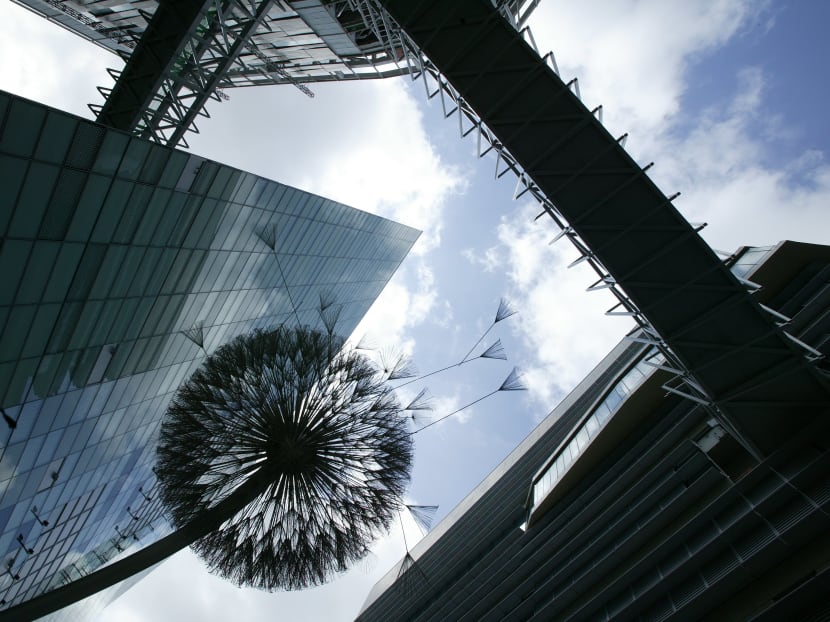Govt pledges S$330m to grow new industry clusters, R&D sector
SINGAPORE — The Government yesterday committed over S$330 million over the next five years towards three new programmes, aimed at growing new industry clusters and creating higher-value jobs here, addressing a growing national challenge in cybersecurity and building up a Singaporean core in the research and development (R&D) sector.

When first conceived, Biopolis was considered a ‘risky venture’ as there was ‘very little capacity in Singapore’. Photo: A*STAR
SINGAPORE — The Government yesterday committed over S$330 million over the next five years towards three new programmes, aimed at growing new industry clusters and creating higher-value jobs here, addressing a growing national challenge in cybersecurity and building up a Singaporean core in the research and development (R&D) sector.
Speaking at a press conference after he chaired a high-powered research council meeting, Prime Minister Lee Hsien Loong said strengthening R&D efforts in the past few years have helped Singapore to become more self-reliant in areas such as energy and water.
“I think we are making good progress,” he said. “The universities are doing strong, better research. Our research is getting better aligned to industry needs, so the investments we have done have capitalised on the growth of the water industry, the interactive and digital media industries. And we are beginning to see some economic dividends.”
But to make further progress, Singapore will need good people. Thus, the Returning Singaporean Scientists Scheme has been launched to attract top overseas-based Singaporean scientists back home to conduct research in areas important to the Republic’s growth.
Mr Lee, who noted “a good number” of Singaporean scientists are based overseas, said: “We should be able to attract some of them back to be part of this national effort. We hope we will anchor their research capabilities here and grow the Singaporean core of this R&D business.”
He stressed that Singapore will remain open to international talent, citing Switzerland, China and Boston in the United States as examples, where, despite their large talent pool, scientists from outside their own countries are still much sought after.
Four industry clusters — diagnostics, speech and language technologies, membranes and additive manufacturing — have been identified under the Innovation Cluster Programme. Some S$200 million has been set aside to strengthen partnerships across companies, universities, research institutes and government agencies to bring ideas more quickly to the market, raise productivity and create jobs.
According to the National Research Foundation, there are specific targets for each cluster, in terms of jobs creation and revenue. For instance, under diagnostics cluster, the target is to have 30 new start-ups.
While this particular programme has the potential to reap more immediate economic benefits, Mr Lee cautioned against expecting immediate results. “We have to strike a balance between assured tangible results, and giving our scientists the flexibility to conduct risky, speculative research, which may take decades to bear through, but which could yield dramatic breakthroughs,” he said, citing NEWater as one example of the result of many years of R&D and “patient, incremental study”.
“We are committed on this for the long haul, and finally its benefit for the society and our economy,” Mr Lee added.
Some S$130 million will be made available under the National Cyberscecurity R&D Programme to support research efforts in seven areas, including threats detection and combatting insider threats.
As Singapore is “a connected, IT dependent economy”, Mr Lee said there is a need to enhance the resilience of Singapore’s IT systems and infrastructure.
Referring to the recent fire which destroyed fibre cables at telco SingTel’s Bukit Panjang Internet Exchange and brought down services to companies and consumers, Mr Lee said, “One malfunction, as you have seen recently in Bukit Panjang, causes disruptions to many people’s work life and conveniences. But malfunction is one thing, security against deliberate threats is another thing.
“All you need is one bad cyber attack averted and you’ve paid back all the research you’ve put into that. Nobody can say our system is safe, that we don’t need to secure it, and nobody can break it.”
The Research, Innovation and Enterprise Council, which comprises 10 Cabinet Ministers and distinguished local and foreign members from the business, science and technology community, meets annually to review and chart Singapore’s research and innovation policies.






